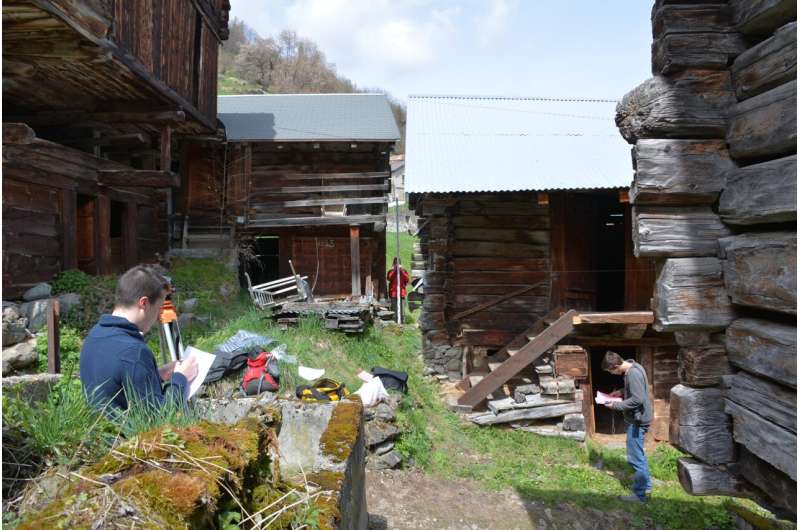Chalets provide insight into our relationship with mountains

Chalets have been widely adopted as the standard form of architecture for mountain homes—but according to Patrick Giromini, an architect and lecturer at EPFL, it's worth taking a close look at why. In a well-documented book, he explores how chalets reflect a societal construct established in the 18th century that has largely shaped our relationship with mountains.
"My research started with a very simple question: what can rural architecture in the Valais mountains teach us about Alpine land use?" says Giromini. For six years, he took architecture students into the mountains in his native canton of Valais to have them sketch the utilitarian buildings found there. "This exercise gives students a better grasp of the rationale behind how the structures were built," he says. "The work done by these students over the years is what brought me to my research hypothesis."
Alongside his teaching, Giromini completed his Ph.D. at EPFL's Arts of Sciences Laboratory (LAPIS), under the supervision of the lab's head Prof. Nicola Braghieri, within EPFL's School of Architecture, Civil and Environmental Engineering (ENAC). Giromini has just published a book based on his Ph.D. research, titled "Transformations silencieuses, Etude architecturale du bâti alpin" (MetisPresses). The book, which is available in French only, can be downloaded free of charge from the publisher's website as part of an open science approach.
To be neither glorified nor preserved at all costs
Giromini's work draws on an in-depth study of the region's history, land records and property laws, as well as case studies primarily in the Val d'Hérens. He takes an indirect yet probing look at modern-day architectural and urban development practices, considering whether the Alpine buildings qualify as local heritage. In his view, rural mountain structures should be neither glorified nor preserved at all costs—they're nothing more than the everyday buildings used by local residents.
"One way to respect and provide continuity in the architectural design principles is to accept the eventual loss of these buildings," he says, fully aware that some people may find his views controversial. "That's actually a sustainable perspective on mountain habitat construction."
Giromini believes that the current trend towards renovating disused structures like raccards—old grain huts—doesn't do them justice. "You can't simply apply contemporary urban methods to mountain buildings," he says. "It doesn't work conceptually or functionally, and it doesn't fit with local norms. It also goes against the very philosophy of the region's development."
As the architect who oversees historical monuments for the canton of Valais, Giromini has raised the issue of using property law to allow such buildings to be deserted. That's because he doesn't want to see mountain villages turned into museums. "The question I have to answer is: do we have the right to make a new window? Our assessment should be based on the material aspects but also social, economic and political ones, because the question goes right to a region's complex heritage."

Drawing inspiration from history
It becomes clear from reading Giromini's work that a more compelling issue underpins his study of traditional mountain architecture: how should today's Alpine communities live within their surroundings? Here too, he believes that history can be a source of inspiration. Mountain villages have always made judicious use of their natural resources and been careful not to overexploit the land or their environment—an approach that comes in stark contrast to current practices. "Is an economy-driven society that's determined to promote tourism in the Alps on a massive scale really the right path for us?" he asks.
Part of Giromini's book is devoted to deconstructing what he calls "Alpine clichés." These clichés have, since the latter part of the 19th century, led local society to make Alpine villages look more and more like little cities—while, ironically, praising the virtues of wholesome, pristine mountain lifestyles.
From chalets to entire regions
Giromini points to the economic success of chalets as one example of this. He's studied the development of chalets starting in the 18th century. "In Valais, chalets were initially used to shelter herders as they brought cattle up from lowland pastures," he says. "They weren't meant to be temporary or permanent residences. But since then, they've become the classic mountain home—at once rustic and exotic—for people who are looking to escape the civilized world without venturing too far away, and who are in search of a quaint setting." In his book, Giromini points out that another reason why chalets have become so widespread is because their architecture can be easily replicated, which builders began doing in the 19th century.
However, Giromini stresses that instead of focusing on old-fashioned chalets, which have been extolled for decades, we should rethink our approach to developing Alpine regions. "It may seem counter-intuitive, but glorifying Alpine villages does them a disservice, and at the same time it condones unstructured, economy-driven urban expansion into city peripheries, especially in industrial areas," he says.
More information: Patrick Giromini, Transformations silencieuses, Etude architecturale du bâti alpin, MetisPresses, 4 November 2022. www.metispresses.ch/fr/transfo … mations-silencieuses
Provided by Ecole Polytechnique Federale de Lausanne





















